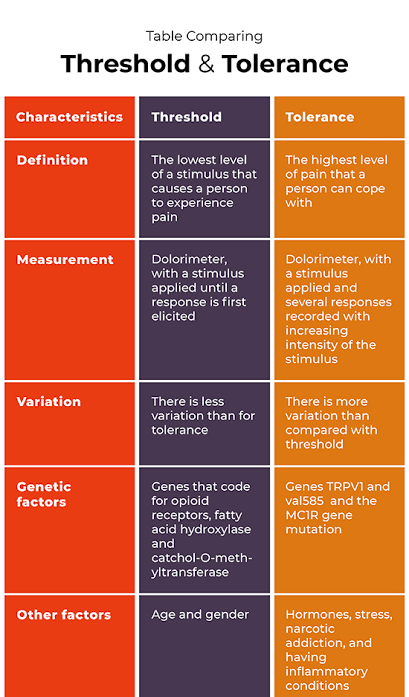WHAT IS PAIN THRESHOLD AND PAIN TOLERANCE?
The intensity of pain caused could vary from minimum to maximum based on how a person perceives, or sense the pain stimulus. This is referred to as pain threshold or tolerance respectively.
Pain is triggered in 2 steps: Biological and brain’s perception of pain. The stimulus is triggered biologically like pricking of skin, further these sensations signal the brain through nerve receptors of the body about experiencing trouble which are registered by the brain and the pain is felt.
Pain has many forms that get triggered from a burn, joint ache, or throbbing headache. Pain tolerance defines the maximum amount of pain your body can handle that differs from person to person. Whereas, pain threshold is the minimum degree at which things like pressure or heat causes pain. Even with slight change in pressure or heat some people might feel pain, this refers to lower pain threshold.

FACTORS AFFECTING PAIN
Pain varies between two people having the exact same physical condition. Studies have reinforced the findings that biological, psychological, and emotional factors impact pain which is perceived by different individuals.
The mind as well as emotions are responsible to either moderate or intensify pain; however, chronic pain might lead to hyper sensitization. Researchers have proved that chronic pain changes the approach followed by the spinal cord, nerves, and brain to process unpleasant stimuli. Past experiences of pain such as trauma, is known to influence a person’s sensitivity and perception of pain.
Some of the common factors contributing to the feeling are an increased amount of pain. Reducing or eliminating these contributing factors by the people suffering from pain might lead to pain being decreased.
SYMPTOMS OF ABDOMINAL PAIN
Abdominal pain could be of forms. The abdominal pain could be described as:
- Stress – This modulates the body’s ability to perceive pain, due to the physical and emotional effects on the body. Stress also contributes factors like anxiety and depression, resulting in a lower pain tolerance.
- Insomnia – Trouble falling asleep and staying asleep diminishes tolerance of pain. This would lead to a low pain threshold.
- Depression – Studies have shown that depression significantly causes frequent, intense, and unpleasant pain complaints in comparison to healthy individuals. The reason for the same is still unknown.
- Drugs – Certain medication would cause pain, and even increase pain, in place of alleviating it. Opioids such as Oxycontin and Vicodin could cause more harm than good sometimes as the body becomes tolerant as well as dependent on these drugs.
- Genetic – Genes play a vital role in determining sensitivity to pain. BH4 genes block a chemical in your body which increases the sensitivity to pain. If BH4 is blocked naturally by the body you become less sensitive to pain with reduced risk for chronic pain.
- Gender – Females feel pain more easily than men as the female’s body releases fewer natural painkillers (beta endorphins) than the male’s body.
- Exercise Level – Regular exercise helps in releasing certain chemicals in the body which are responsible for higher threshold for pain.
- Brain receptors – Brain’s wiring play a major role in pain threshold. As per a study there is a correlation between sensitivity to pain in an individual and the thickness of the cortex in the brain. Lesser is the gray matter in the brain, higher would be the pain sensitivity.
Renal Artery Stenosis

PAIN THRESHOLD
Pain Threshold is defined as the lowest intensity of a given stimulus that is perceived as painful to a person. This is comparatively constant across people for a given stimulus. Pain threshold is entirely subjective in nature and it is based on gender, stress level and genetic makeup.
Pain threshold is categorically the experience of the person suffering from pain, while the intensity measured is based on an external event. It has been a common misconception to define the pain threshold in terms of the stimulus, and that should be avoided. However, the stimulus is not pain itself and cannot be the measure of pain.
Pain is defined as both a biochemical and neurological transmission caused by an unpleasant sensation or an emotional experience.
The degree at which the stimulus starts to evoke pain might vary from individual to individual and it is based on time.
Factors affecting pain threshold are:
- Heat – Heat pain threshold is the temperature at which heat causes pain to the recipient. People with morning orientation are less susceptible to heat related pain in comparison to evening oriented people.
- Sound – Pain threshold for pressure is the pressure at which sound intensity turns out to be painful for a listener. Threshold pressure for sound intensity fluctuates with frequency and might be age-dependent. Exposure to frequent noise or high intensity music in people usually partakes of a higher threshold pressure. The change in threshold could also cause threshold pressure acceptance to vary. Prolonged exposure to sound at levels evoking pain can lead to physical damage, or even hearing impairment.
PAIN TOLERANCE
Pain tolerance refers to the maximum level of pain you are able to tolerate. Pain tolerance is different from pain threshold which is the point at which you begin to feel pain. The perception of pain tolerance has two major components: biological components such as the headache or skin prickling which activates pain receptors and the brain’s perception of pain such as focus spent while paying attention to or ignoring the pain. The brain’s perception of pain is mainly a response to signals triggered from pain receptors which sense the pain in the first place.
Pain tolerance is affected by people’s emotions, bodies, and lifestyles such as:
- Depression and anxiety could make a person more sensitive to pain
- Athletes are trained to withstand more pain in comparison to other people who don’t exercise
- Smokers and/or obese people complaint of more pain
- Biological factors include genetics, injuries like spinal cord damage, and chronic diseases such as diabetes that cause nerve damage. An individual’s biological makeup also affects the development of resistance to pain medicines that would mean a treatment that once worked for an individual would no longer ease the pain.
- Age plays an important role in pain tolerance. Elderly individuals may have a higher pain tolerance.
- Sex – Females usually complaint about longer-lasting and more severe pain levels in comparison to males.
- Chronic illness such as migraines or fibromyalgia, can alter your pain tolerance.
- Mental illness – Pain is more often described in people suffering from depression or panic disorder.
- Stress – Being under constant stress could aggravate pain to a more severe form.
- Social isolation – This may add to the lower pain threshold and decrease your pain tolerance.

TESTING PAIN TOLERANCE AND THRESHOLD
Pain tolerance is usually difficult to measure, however several methods help in determining the appropriate pain tolerance by:
- Dolorimetry – This uses an instrument known as dolorimeter that helps to assess pain threshold and pain tolerance with the help of different types of stimulus such as heat, pressure, or electrical stimulation.
- Cold Press Method – This involves submerging the hand into a bucket of ice-cold water to determine the pain threshold.
- Pain Intensity Scale – This is a qualitative method to determine the trigger sources of pain and its intensity.
OUTLOOK
Experiencing pain is a complex phenomenon. Though you can’t always change the source of your pain, there are ways to alter your perception of pain. Some researchers believe that regular exposure to pain would increase the pain’s tolerance and its threshold.
If you or anyone you know is suffering from pain, our expert providers at Specialty Care Clinics will take care of your health and help you recover.
Call us on 469-545-9983 to book an appointment with our specialists.
